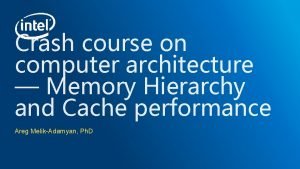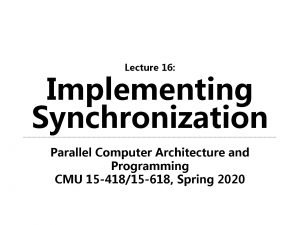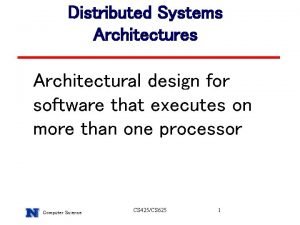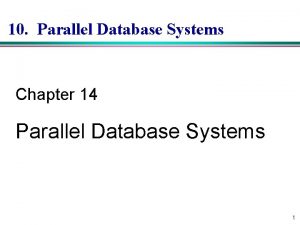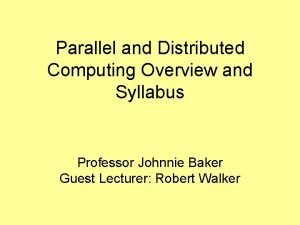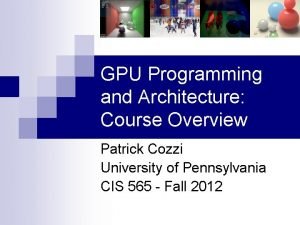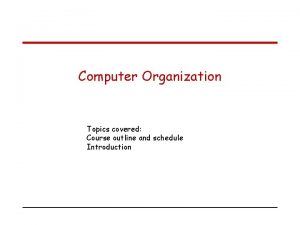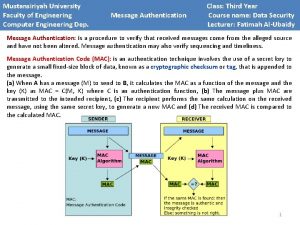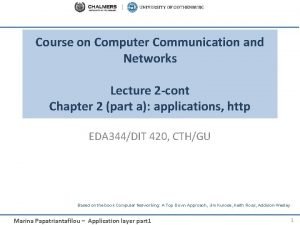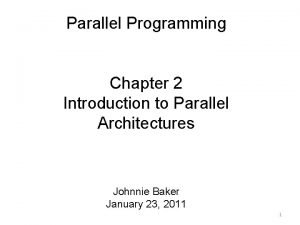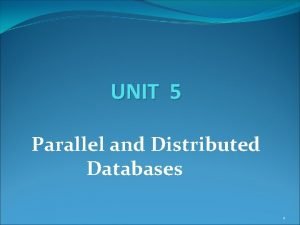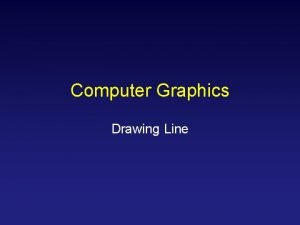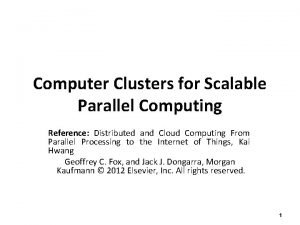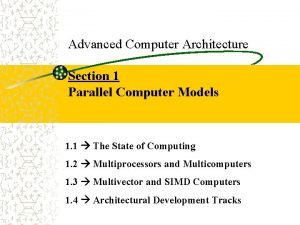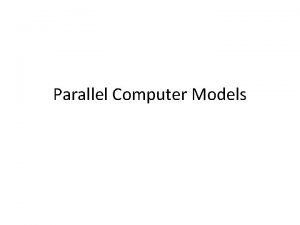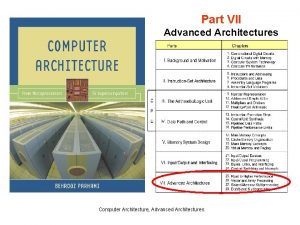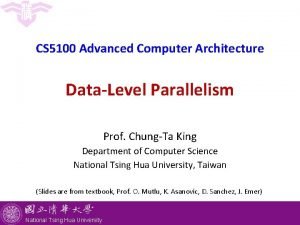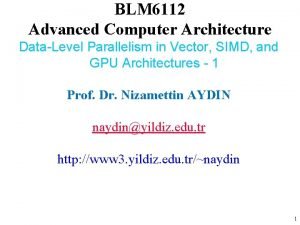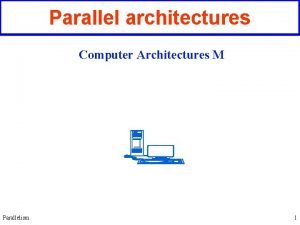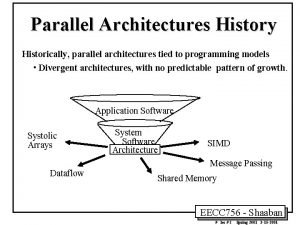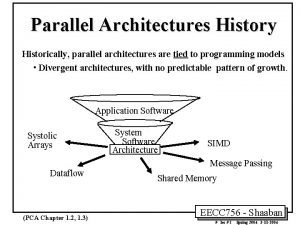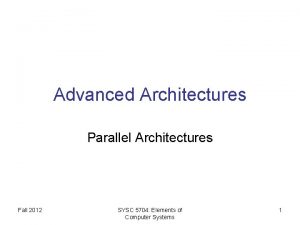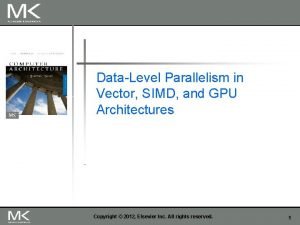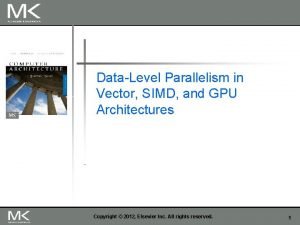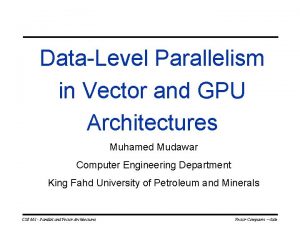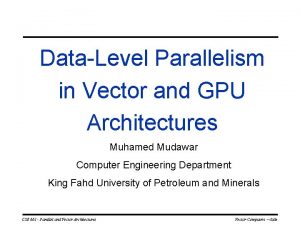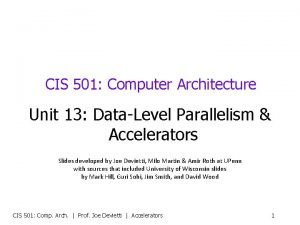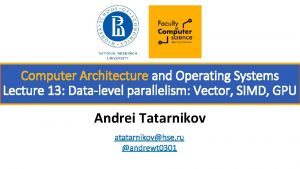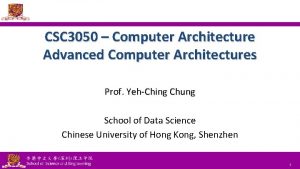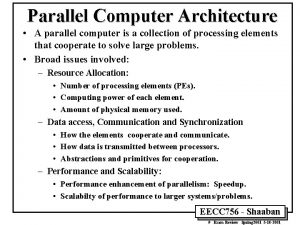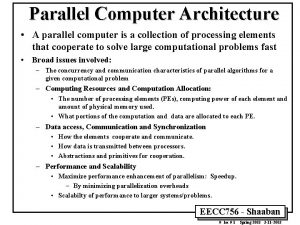Advanced Computer Architecture DataLevel Parallel Architectures Course 5


























































![Conditional Branching Example if (X[i] != 0) X[i] = X[i] – Y[i]; else X[i] Conditional Branching Example if (X[i] != 0) X[i] = X[i] – Y[i]; else X[i]](https://slidetodoc.com/presentation_image/1c4d336a4d34b576febbfff631ef1bc5/image-59.jpg)













![Loop-Level Parallelism • Example 2: for (i=0; i<100; i=i+1) { A[i+1] = A[i] + Loop-Level Parallelism • Example 2: for (i=0; i<100; i=i+1) { A[i+1] = A[i] +](https://slidetodoc.com/presentation_image/1c4d336a4d34b576febbfff631ef1bc5/image-73.jpg)
![Loop-Level Parallelism • Example 3: for (i=0; i<100; i=i+1) { A[i] = A[i] + Loop-Level Parallelism • Example 3: for (i=0; i<100; i=i+1) { A[i] = A[i] +](https://slidetodoc.com/presentation_image/1c4d336a4d34b576febbfff631ef1bc5/image-74.jpg)
![Loop-Level Parallelism • Example 4: for (i=0; i<100; i=i+1) { A[i] = B[i] + Loop-Level Parallelism • Example 4: for (i=0; i<100; i=i+1) { A[i] = B[i] +](https://slidetodoc.com/presentation_image/1c4d336a4d34b576febbfff631ef1bc5/image-75.jpg)


![Finding dependencies • Example 2: for (i=0; i<100; i=i+1) { Y[i] = X[i] / Finding dependencies • Example 2: for (i=0; i<100; i=i+1) { Y[i] = X[i] /](https://slidetodoc.com/presentation_image/1c4d336a4d34b576febbfff631ef1bc5/image-78.jpg)
![Reductions • Reduction Operation: for (i=9999; i>=0; i=i-1) sum = sum + x[i] * Reductions • Reduction Operation: for (i=9999; i>=0; i=i-1) sum = sum + x[i] *](https://slidetodoc.com/presentation_image/1c4d336a4d34b576febbfff631ef1bc5/image-79.jpg)

- Slides: 80

Advanced Computer Architecture Data-Level Parallel Architectures Course 5 MD 00 Henk Corporaal January 2015 h. corporaal@tue. nl Advanced Computer Architecture pg

This lecture Data-level parallel architectures • Vector machine • SIMD (Single Instruction Multiple Data) processors – sub-word parallelism support • GPU (Graphic Processing Unit) • Material: – Book of Hennessy & Patterson – Study: Chapter 4: 4. 1 -4. 7 – (extra material: app G: vector processors) Advanced Computer Architecture pg 2

Data Parallelism • Vector operations • Multiple data elements per operation, e. g. – ADDV V 1, V 2, V 3 // forall i V 1[i] = V 2[i]+V 3[i] • Executed using either – Vector archtitecture: highly pipelined (fast clocked) FU (function unit) – SIMD: multiple FUs acting in parallel or time SIMD architecture Vector architecture Advanced Computer Architecture pg 3

SIMD vs MIMD • SIMD architectures can exploit significant data-level parallelism for: – matrix-oriented scientific computing – media-oriented image and sound processors • SIMD is more energy efficient than MIMD – Only needs to fetch and decode one instruction per data operation – Makes SIMD attractive for personal mobile devices • SIMD allows programmer to continue to think sequentially • MIMD is more generic: why? Advanced Computer Architecture pg 4

Vector Architecture Basic idea: – Read sets of data elements into “vector registers” – Operate on those registers – Disperse the results back into memory Registers are controlled by compiler – Used to hide memory latency • by loading data early (many cycles before their use) – Leverage memory bandwidth Advanced Computer Architecture pg 5

Example architecture: VMIPS • Loosely based on Cray-1 • Vector registers – Each register holds a 64 -element, 64 bits/element vector – Register file has 16 read- and 8 write-ports • Vector functional units – Fully pipelined – Data and control hazards are detected Cray-1 1976 • Vector load-store unit – Fully pipelined – One word per clock cycle after initial latency • Scalar registers – 32 general-purpose registers – 32 floating-point registers Advanced Computer Architecture pg 6

VMIPS Instructions • ADDVV. D: add two vectors (of Doubles) • ADDVS. D: add vector to a scalar (Doubles) • LV/SV: vector load and vector store from address • Example: DAXPY ((double) Y=a*X+Y), inner loop of Linpack L. D LV MULVS. D LV ADDVV SV F 0, a V 1, Rx V 2, V 1, F 0 V 3, Ry V 4, V 2, V 3 Ry, V 4 ; load scalar a ; load vector X ; vector-scalar multiply ; load vector Y ; add ; store the result • Requires 6 instructions vs. almost 600 for MIPS Advanced Computer Architecture pg 7

Vector Execution Time • Execution time depends on three factors: 1. Length of operand vectors 2. Structural hazards 3. Data dependencies • VMIPS functional units consume one element per clock cycle – Execution time is approximately the vector length: Texec ~ Vl • Convey – Set of vector instructions that could potentially execute together Advanced Computer Architecture pg 8

Chimes • Sequences with read-after-write dependency hazards can be in the same convey via chaining • Chaining – Allows a vector operation to start as soon as the individual elements of its vector source operand become available • Chime – Unit of time to execute one convey – m conveys executes in m chimes – For vector length of n, requires m x n clock cycles Advanced Computer Architecture pg 9

Example LV MULVS. D LV ADDVV. D SV Convoys: 1 2 3 • • • LV LV SV V 1, Rx V 2, V 1, F 0 V 3, Ry V 4, V 2, V 3 Ry, V 4 -> -> ; load vector X ; vector-scalar multiply ; load vector Y ; add two vectors ; store the sum MULVS. D ADDVV. D 3 chimes, 2 FP ops per result, cycles per FLOP = 1. 5 For 64 element vectors, requires 64 x 3 = 192 clock cycles Question: why not combining Convoys 2 and 3 into one? Advanced Computer Architecture pg 10

Challenges • Start up time: – Latency of vector functional unit – Assume the same as Cray-1 • • Floating-point add => 6 clock cycles Floating-point multiply => 7 clock cycles Floating-point divide => 20 clock cycles Vector load => 12 clock cycles • Improvements: – > 1 element per clock cycle – Non-64 wide vectors – IF statements in vector code – Memory system optimizations to support vector processors – Multiple dimensional matrices – Sparse matrices – HLL support: Programming a vector computer Advanced Computer Architecture pg 11

Multiple Lanes • Left: single lane • Right: 4 lanes; vector elements are interleaved ! Advanced Computer Architecture pg 12

Multiple lanes structure • 4 lanes • 3 vector units: ADD, MUL, LDST • Not shown: scalar processor can broadcast a scalar to all vector units Advanced Computer Architecture pg 13

Memory Banks to/from load-store units interconnect, connecting banks to ld-st ports bank 0 bank 1 bank 2 bank N-1 • Banks are (usually) single ported (1 rd/wr port) • To the load-store units the memory system looks multiported except for bank conflicts Advanced Computer Architecture pg 14

Memory Banks • Memory system must be designed to support high bandwidth for vector loads and stores • Spread accesses across multiple banks – Control bank addresses independently – Load or store non sequential words – Support multiple vector processors sharing the same memory • Example: – 32 processors, each generating 4 loads and 2 stores/cycle – Processor cycle time is 2. 167 ns, SRAM cycle time is 15 ns – How many memory banks needed? – Answer: think about how many accesses are needed in 15 ns ! Advanced Computer Architecture pg 15

Vector Length Register • Vector length not known at compile time? • Use Vector Length Register (VLR) • Use strip mining for vectors over the maximum length: low = 0; VL = (n % MVL); /*find odd-size piece using modulo % */ for (j = 0; j <= (n/MVL); j=j+1) { /*outer loop*/ for (i = low; i < (low+VL); i=i+1) /*runs for length VL*/ Y[i] = a * X[i] + Y[i] ; /*main operation*/ low = low + VL; /*start next vector*/ VL = MVL; /*reset length to maximum vector length*/ } Execution order: Advanced Computer Architecture pg 16

Vector Mask Registers • Consider: for (i = 0; i < 64; i=i+1) if (X[i] != 0) X[i] = X[i] – Y[i]; • Use vector mask register to “disable” elements: LV L. D SNEVS. D SUBVV. D SV V 1, Rx V 2, Ry F 0, #0 V 1, F 0 V 1, V 2 Rx, V 1 ; load vector X into V 1 ; load vector Y ; load FP zero into F 0 ; sets VM(i) to 1 if V 1(i)!= F 0 ; subtract under vector mask ; store the result in X • GFLOPS rate decreases! Why? ? ? Advanced Computer Architecture pg 17

Stride (see pg 278 e. v. ) • Consider matrix multiplication: A=B*D for (i = 0; i < 100; i=i+1) for (j = 0; j < 100; j=j+1) { A[i][j] = 0. 0; for (k = 0; k < 100; k=k+1) A[i][j] = A[i][j] + B[i][k] * D[k][j]; } • Must vectorize multiplication of rows of B with columns of D • Use non-unit stride j A B i, j = i D * Advanced Computer Architecture pg 18

Stride • Bank conflict (stall) occurs when the same bank is hit faster than bank busy time: – LCM(stride, N_banks) / Stride < bank busy time LCM = least common multiple Example: • E. g. stride = 6, 16 banks, you hit bank 0, 6, 12, 2, 8, 14, 4, etc. ; you hit the same bank after LCM(6, 16)/6 = 48/6 = 8 cycles. • If busy time > 8 cycles you have to wait Advanced Computer Architecture pg 19

Stride • See example pg 279 – 8 memory banks, busy time 6 cycles, memory latency 12 cycles – Q: how long does it take to complete a 64 -element vector load a) with stride 1 b) with stride 32 • Answer a) stride 1: 12+64 = 76 cycles (= 1. 2 cycles/element) b) stride 32: Since 32 = 4*8, every access goes to the same bank ! Every access after the first has to wait the 6 cycles busy time => 12+1+6*63 = 391 cycles (=6. 1 cycles/element) Advanced Computer Architecture pg 20

Scatter-Gather • Consider indirect vector access: for (i = 0; i < n; i=i+1) A[K[i]] = A[K[i]] + C[M[i]]; • Use index vector to load e. g. only the non-zero elements of A into vector Va: LV LVI ADDVV. D SVI Vk, Rk Va, (Ra+Vk) Vm, Rm Vc, (Rc+Vm) Va, Vc (Ra+Vk), Va ; load K ; load A[K[]] ; load M ; load C[M[]] ; add them ; store A[K[]] Advanced Computer Architecture pg 21

Programming Vector Architectures • Compilers can provide feedback to programmers • Programmers can provide hints to compiler (last column): Advanced Computer Architecture pg 22

Sub-word Parallelism • Divide word into multiple parts (sub-words) and perform operations on these parts in parallel Advanced Computer Architecture pg 23

SIMD Extensions • Media applications operate on data types narrower than the native word size – Example: disconnect carry chains to “partition” adder • Limitations, compared to vector instructions: – Number of data operands encoded into op code – No sophisticated addressing modes (strided, scatter-gather) – No mask registers Advanced Computer Architecture pg 24

SIMD Implementations • Implementations: – Intel MMX (1996) • Eight 8 -bit integer ops or four 16 -bit integer ops – Streaming SIMD Extensions (SSE, 1999) • Eight 16 -bit integer ops • Four 32 -bit integer/fp ops or two 64 -bit integer/fp ops – Advanced Vector Extensions (AVE, 2010) • Four 64 -bit integer/fp ops – Operands must be consecutive and aligned memory locations E. g. 16 bytes in parallel: + Advanced Computer Architecture pg 25

Example SIMD Code • Example DXPY: (double) Y = a×X + Y (see pg 284 -285) L. D MOV MOV DADDIU Loop: L. 4 D MUL. 4 D ADD. 4 D S. 4 D DADDIU DSUBU BNEZ F 0, a F 1, F 0 F 2, F 0 F 3, F 0 R 4, Rx, #512 ; load scalar a ; copy a into F 1 for SIMD MUL ; copy a into F 2 for SIMD MUL ; copy a into F 3 for SIMD MUL ; last address to load F 4, 0[Rx] F 4, F 0 F 8, 0[Ry] F 8, F 4 0[Ry], F 8 Rx, #32 Ry, #32 R 20, R 4, Rx R 20, Loop ; load X[i], X[i+1], X[i+2], X[i+3] ; a×X[i], a×X[i+1], a×X[i+2], a×X[i+3] ; load Y[i], Y[i+1], Y[i+2], Y[i+3] ; a×X[i]+Y[i], . . . , a×X[i+3]+Y[i+3] ; store in Y[i], Y[i+1], Y[i+2], Y[i+3] ; increment index to X ; increment index to Y ; compute bound ; check if done Advanced Computer Architecture pg 26

Performance model • What is peak performance of an architecture – compute limited? – memory bandwidth limited? Advanced Computer Architecture pg 27

Roofline Performance Model • Basic idea: – Plot peak floating-point throughput as a function of arithmetic intensity – Ties together floating-point performance and memory performance for a target machine • Arithmetic intensity = – Floating-point operations per byte read from memory Advanced Computer Architecture pg 28

Examples • Max GFLOPs/sec = Min (Peak Memory BW × Arithmetic Intensity, Peak Fl. Point Perf. ) NEC SX-9: vector processor (2008) Advanced Computer Architecture pg 29

Graphic Processing Units (GPUs) NVIDIA GT 340 (2010) ATI 5970 (2009) Advanced Computer Architecture pg 30

Why GPUs Advanced Computer Architecture pg 31

In need of Tera. Flops on your desk? 3 * Nvidia GTX 295 • 1440 PEs • 5. 3 Tera. Flop Advanced Computer Architecture pg 32

How Do GPUs Spend Their Die Area? GPUs are designed to match the workload of 3 D graphics. Nvidia GTX 280 • most area spend on processing • relatively small on-chip memories • huge off-chip memory latencies J. Roca, et al. "Workload Characterization of 3 D Games", IISWC 2006, link T. Mitra, et al. "Dynamic 3 D Graphics Workload Characterization and the Architectural Implications", Micro 1999, link Advanced Computer Architecture pg 33

How Do CPUs Spend Their Die Area? CPUs are designed for low latency instead of high throughput Die photo of Intel Penryn (source: Intel) Advanced Computer Architecture pg 34

Graphical Processing Units • Given the hardware invested to do graphics well, how can be supplement it to improve performance of a wider range of applications? • Basic idea: – Heterogeneous execution model • CPU is the host, GPU is the device – Develop a C-like programming language for GPU – Unify all forms of GPU parallelism as CUDA thread – Programming model is SIMT: “Single Instruction Multiple Thread” Advanced Computer Architecture pg 35

CPU vs. GPU • Different design philosophies: – CPU • A few out-of-order cores with huge caches • Sequential computation – GPU • Many in-order cores • Massively parallel computation Advanced Computer Architecture pg 36

System Architecture Erik Lindholm, et al. "NVIDIA Tesla: A Unified Graphics and Computing Architecture", IEEE Micro 2008, link Advanced Computer Architecture pg 37

GPUs: what's inside? Basically it's an SIMD: • A single instruction stream operates on multiple data streams • All PEs execute the same instruction at the same time • PEs operate concurrently on their own piece of memory • However, GPU is far more complex !! Add Add Add • • Advanced Computer Architecture pg 38

CPU Programming: NVIDIA CUDA example • CUDA program expresses data level parallelism (DLP) in terms of thread level parallelism (TLP). • Hardware converts TLP into DLP at run time. Single thread program float A[4][8]; do-all(i=0; i<4; i++){ do-all(j=0; j<8; j++){ A[i][j]++; } } Now I specify 4*1*8*1 threads CUDA program float A[4][8]; kernel. F<<<(4, 1), (8, 1)>>>(A); __device__ kernel. F(A){ i = block. Idx. x; j = thread. Idx. x; A[i][j]++; } Advanced Computer Architecture pg 39

Warp: Basic Scheduling Unit in Hardware • Blocks are defined by programmer • Warps are transparent to programmer, formed at load/run time – One warp consists of 32 consecutive threads Advanced Computer Architecture pg 40

Scheduling of SIMD threads • SM hardware implements zerooverhead warp scheduling SIMD thread scheduler – Operands ready? => Eligible for execution time warp 8 instruction 11 warp 1 instruction 42 warp 3 instruction 95. . . warp 8 instruction 12 warp 3 instruction 96 Advanced Computer Architecture 41 pg 41

Thread scheduling to hide latencies • Long latency operations (memory accesses, special function units) => latency hiding by scheduling many warps in between dependend operations 4 active warps (or SIMD threads) 2 active warps Advanced Computer Architecture pg 42

Handling Branch: Warp Divergence !! • Threads within a warp are free to branch. if( $r 17 > $r 19 ){ $r 16 = $r 20 + $r 31 } else{ $r 16 = $r 21 - $r 32 } $r 18 = $r 15 + $r 16 Assembly code on the right are disassembled from cuda binary (cubin) using "decuda", link Advanced Computer Architecture pg 43

Branch Divergence within a Warp • If threads within a warp diverge, both paths have to be executed. • Masks are set to filter out threads not executing on current path. Advanced Computer Architecture pg 44

CPU Programming: NVIDIA CUDA example • CUDA program expresses data level parallelism (DLP) in terms of thread level parallelism (TLP). • Hardware converts TLP into DLP at run time. Single thread program float A[4][8]; do-all(i=0; i<4; i++){ do-all(j=0; j<8; j++){ A[i][j]++; } } CUDA program float A[4][8]; kernel. F<<<(2, 2), (4, 2)>>>(A); __device__ kernel. F(A){ i = block. Idx. x; j = thread. Idx. x; A[i][j]++; } Advanced Computer Architecture pg 45

CUDA Programming Both grid and thread block can have two dimensional index kernel. F<<<(2, 2), (4, 2)>>>(A); __device__ kernel. F(A){ i = block. Dim. x * block. Idx. y + block. Idx. x; j = thread. Dim. x * thread. Idx. y + thread. Idx. x; A[i][j]++; } Advanced Computer Architecture pg 46

Mapping Thread Blocks to SMs Rules of the game: • One thread block can only run on one SM (Stream. Multiprocessor) • Thread block can not migrate from one SM to another SM • Threads of the same thread block can share data using shared memory Example: mapping 12 thread blocks on 4 SMs. Advanced Computer Architecture pg 47

CUDA Compilation Trajectory cudafe: CUDA front end nvopencc: customized open 64 compiler for CUDA ptx: high level assemble code (documented) ptxas: ptx assembler cubin: CUDA binrary decuda, http: //wiki. github. com/laanwj/decuda Advanced Computer Architecture pg 48

Threads and Blocks • A thread is associated with each data element / loop body • Threads are organized into blocks • Blocks are organized into a grid • GPU hardware handles thread management, not applications or OS Advanced Computer Architecture pg 49

CUDA programming model • • Arrangment: Threads Blocks Grid (see also fig 4. 13) Single-instruction multiple-thread (SIMT) fashion Advanced Computer Architecture pg 50

Multi-threaded SIMD processor - Shown a single SM (streaming Multiprocessor with 16 lanes - Warp = thread of SIMD instructions Advanced Computer Architecture pg 51

Example • DAXPY (Y=a. X + Y): vectors of length 8192 – Independent loop iterations – Threads in thread blocks // DAXPY in C for (int i = 0; i < 8192; ++i) y[i] = a * x[i] + y[i]; // n = 8192 // DAXPY in CUDA GPU code { int i = block. Idx. x * block. Dim. x + thread. Idx. x; if(i < n) y[i] = a * x[i] + y[i]; }. . . // Kernel invocation CPU daxpy<<16, 512>>(n, a, x, y); this grid has 16 blocks, each with 512 threads (block. Dim = 512) Advanced Computer Architecture pg 52

Transparent Scalability • Thread block scheduler assigns blocks to any multithreaded SIMD processor at any time Kernel grid Block 0 Block 1 Device with 2 SMs Block 2 Block 3 Device with 4 SMs Block 4 Block 5 Block 6 Block 7 Block 2 Block 1 Block 3 Block 4 Block 5 Block 6 Block 7 time Block 0 Block 1 Block 2 Block 3 Block 4 Block 5 Block 6 Block 7 Each block can execute in any order relative to other blocks Advanced Computer Architecture pg 53

GPU computational structures • Blocks within each SIMD processor: – SIMD lanes: 32 in NVIDIA devices – Wide and shallow compared to vector processors • Threads of SIMD instructions: Warps – Each Warp has its own PC – SIMD thread scheduler uses scoreboard to dispatch – No data dependencies between threads! – Keeps track of up to 48 warps (Fermi) • Latency hiding Advanced Computer Architecture pg 54

Example • Multiply two vectors of length 8192 • Code that works over all elements is the grid • Thread blocks break this down into manageable sizes – 512 threads per block • Thus grid size = 16 blocks • Block is assigned to a multithreaded SIMD processor by the thread block scheduler • Block is analogous to a strip-mined vector loop with vector length of 32 • SIMD instruction execute (e. g. ) 32 elements at a time • Fermi generation of GPUs has 7 -15 multithreaded SIMD processors (called SMs: Streaming Multi-processors) Advanced Computer Architecture pg 55

Example • NVIDIA GPU having 32, 768 registers – Divided into lanes – Each SIMD thread is limited to 64 registers – SIMD thread has up to: • 64 vector registers of 32 32 -bit elements • 32 vector registers of 32 64 -bit elements – Fermi architecture has 16 physical SIMD lanes, each containing 2048 registers Advanced Computer Architecture pg 56

NVIDIA Instruction Set Arch. • ISA is an abstraction of the hardware instruction set – “Parallel Thread Execution (PTX)” – Uses virtual registers – Translation to machine code is performed in software – Example PTX code of 1 DAXPY iteration: shl. s 32 add. s 32 shl. u 32 ld. global. f 64 mul. f 64 add. f 64 st. global. f 64 R 8, block. Idx, 9 ; Thread Block ID*Block size (512=29) R 8, thread. Idx ; R 8 = i = my CUDA thread ID R 8, 3 ; byte offset RD 0, [X+R 8] ; RD 0 = X[i] RD 2, [Y+R 8] ; RD 2 = Y[i] RD 0, RD 4 ; Product in RD 0 = RD 0 * RD 4 (scalar a) RD 0, RD 2 ; Sum in RD 0 = RD 0 + RD 2 (Y[i]) [Y+R 8], RD 0 ; Y[i] = sum (X[i]*a + Y[i]) R 8 contains unique id for each of the 8192 threads (calculated by first 3 instructions) Advanced Computer Architecture pg 57

Conditional Branching • Like vector architectures, GPU branch hardware uses internal masks • Also uses – Branch synchronization stack • Entries consist of masks for each SIMD lane • I. e. which threads commit their results (all threads execute) – Instruction markers to manage when a branch diverges into multiple execution paths • Push on divergent branch – …and when paths converge • Act as barriers • Pops stack • Per-thread-lane 1 -bit predicate register, specified by programmer Advanced Computer Architecture pg 58
![Conditional Branching Example if Xi 0 Xi Xi Yi else Xi Conditional Branching Example if (X[i] != 0) X[i] = X[i] – Y[i]; else X[i]](https://slidetodoc.com/presentation_image/1c4d336a4d34b576febbfff631ef1bc5/image-59.jpg)
Conditional Branching Example if (X[i] != 0) X[i] = X[i] – Y[i]; else X[i] = Z[i]; Assume R 8 contains (scaled) thread-id: ld. global. f 64 RD 0, [X+R 8] setp. neq. s 32 P 1, RD 0, #0 @!P 1, bra ELSE 1, *Push ; RD 0 = X[i] ; P 1 is predicate register = (X[i]!=0) ; Push old mask, set new mask bits ; if P 1 false, go to ELSE 1 ld. global. f 64 RD 2, [Y+R 8] ; RD 2 = Y[i] sub. f 64 RD 0, RD 2 ; Difference in RD 0 st. global. f 64 [X+R 8], RD 0 ; X[i] = RD 0 @P 1, bra ENDIF 1, *Comp ; complement mask bits ; if P 1 true, go to ENDIF 1 ELSE 1: ld. global. f 64 RD 0, [Z+R 8] ; RD 0 = Z[i] st. global. f 64 [X+R 8], RD 0 ; X[i] = RD 0 ENDIF 1: <next instruction>, *Pop ; pop to restore old mask Advanced Computer Architecture pg 59

NVIDIA GPU Memory Structures • Each SIMD Lane has private section of off-chip DRAM – “Private memory” – Contains stack frame, spilling registers, and private variables • Each multithreaded SIMD processor also has local memory – Shared by SIMD lanes / threads within a block • Memory shared by SIMD processors is GPU Memory – Host can read and write GPU memory Advanced Computer Architecture pg 60

NVIDIA GPU Memory Structures CUDA Thread Private Memory Block Local Memory Grid 0 . . . Global Memory Grid 1 Sequential Grids in Time . . . Advanced Computer Architecture pg 61

Fermi Architecture • Each SIMD processor has – Two SIMD thread schedulers, two instruction dispatch units – 16 SIMD lanes (SIMD width=32, chime=2 cycles), 16 loadstore units, 4 special function units – Thus, two threads of SIMD instructions are scheduled every two clock cycles • Fast double precision • Caches for GPU memory: L 1, L 2 • 64 -bit addressing and unified address space • Error correcting codes • Faster context switching • Faster atomic instructions Advanced Computer Architecture pg 62

Fermi Multithreaded SIMD Proc. Advanced Computer Architecture pg 63

Kepler Architecture Innovations • Each SIMD processor has – 4 SIMD thread schedulers – Each with 2 dispatch units – Instruction Level Parallelism – 32 SIMD lanes for each SIMD thread (chime = 1 cycle) – Thus, two instructions of 4 threads of SIMD instructions are scheduled every clock cycle • Compiler determines when instructions are ready to issue – This information is included in the instruction • Even faster atomic instructions • Shuffle instructions Advanced Computer Architecture pg 64

Kepler Multithreaded SIMD Proc. Advanced Computer Architecture pg 65

Maxwell: more energy efficient • Successor of Kepler: • Feb 2014 -> Ge. Forse GTX 750 series • L 2 increased from 256 Ki. B to 2 Mi. B • Memory bus reduced from 192 to 128 bits (saving power) • 4 warp schedulers (per SM) do not share cores anymore – Texture units and FP 64 still shared • Claims, compared to Kepler – 1. 35 x performance per core – 2 x more energy efficient Advanced Computer Architecture pg 66

Maxwell vs. Kepler: comparing 1 SM Advanced Computer Architecture pg 67

Maxwell vs. Kepler vs. Fermi Mandelbroth Advanced Computer Architecture pg 68

GPUs vs. Vector machines • Similarities to vector machines: – Works well with data-level parallel problems – Scatter-gather transfers – Mask registers – Large register files • GPU Differences: – No scalar processor • use Host processor for this – Uses multithreading to hide memory latency – Has many functional units, as opposed to a few deeply pipelined units like a vector processor Advanced Computer Architecture pg 69

GPUs vs. Vector machines (pg 308 e. v. ) Advanced Computer Architecture pg 70

Loop-Level Parallelism • Detection of parallelism • Enhancing loop parallelism Advanced Computer Architecture pg 71

Detecting Loop-Level Parallelism • Focuses on determining whether data accesses in later iterations are dependent on data values produced in earlier iterations – Loop-carried dependence • Example 1: for (i=999; i>=0; i=i-1) x[i] = x[i] + s; • No loop-carried dependence Advanced Computer Architecture pg 72
![LoopLevel Parallelism Example 2 for i0 i100 ii1 Ai1 Ai Loop-Level Parallelism • Example 2: for (i=0; i<100; i=i+1) { A[i+1] = A[i] +](https://slidetodoc.com/presentation_image/1c4d336a4d34b576febbfff631ef1bc5/image-73.jpg)
Loop-Level Parallelism • Example 2: for (i=0; i<100; i=i+1) { A[i+1] = A[i] + C[i]; /* S 1 */ B[i+1] = B[i] + A[i+1]; /* S 2 */ } • S 1 and S 2 use values computed by S 1 in previous iteration • S 2 uses value computed by S 1 in same iteration Advanced Computer Architecture pg 73
![LoopLevel Parallelism Example 3 for i0 i100 ii1 Ai Ai Loop-Level Parallelism • Example 3: for (i=0; i<100; i=i+1) { A[i] = A[i] +](https://slidetodoc.com/presentation_image/1c4d336a4d34b576febbfff631ef1bc5/image-74.jpg)
Loop-Level Parallelism • Example 3: for (i=0; i<100; i=i+1) { A[i] = A[i] + B[i]; /* S 1 */ B[i+1] = C[i] + D[i]; /* S 2 */ } • S 1 uses value computed by S 2 in previous iteration but dependence is not circular so loop is parallel • Transform to: A[0] = A[0] + B[0]; // prologue for (i=0; i<99; i=i+1) { B[i+1] = C[i] + D[i]; A[i+1] = A[i+1] + B[i+1]; } B[100] = C[99] + D[99]; // epilogue Advanced Computer Architecture pg 74
![LoopLevel Parallelism Example 4 for i0 i100 ii1 Ai Bi Loop-Level Parallelism • Example 4: for (i=0; i<100; i=i+1) { A[i] = B[i] +](https://slidetodoc.com/presentation_image/1c4d336a4d34b576febbfff631ef1bc5/image-75.jpg)
Loop-Level Parallelism • Example 4: for (i=0; i<100; i=i+1) { A[i] = B[i] + C[i]; D[i] = A[i] * E[i]; } • Example 5: for (i=1; i<100; i=i+1) { Y[i] = Y[i-1] + Y[i]; } Advanced Computer Architecture pg 75

Finding dependencies • Assume array indices are affine (i. e. linear function of loop indices), e. g. : – a x i + b (i is loop index) • Assume: – Store to a x i + b, then – Load from c x i + d – i runs from m to n – Dependence exists if: • Given j, k such that m ≤ j ≤ n, m ≤ k ≤ n • Store to a x j + b, load from a x k + d, and a x j + b = c x k + d Advanced Computer Architecture pg 76

Finding dependencies • Test for absence of a dependence: – GCD test: • If a dependency exists, GCD(c, a) must evenly divide (d-b) • Example: for (i=0; i<100; i=i+1) { X[2*i+3] = X[2*i] * 5. 0; } • Cannot always determine dependencies at compile time Advanced Computer Architecture pg 77
![Finding dependencies Example 2 for i0 i100 ii1 Yi Xi Finding dependencies • Example 2: for (i=0; i<100; i=i+1) { Y[i] = X[i] /](https://slidetodoc.com/presentation_image/1c4d336a4d34b576febbfff631ef1bc5/image-78.jpg)
Finding dependencies • Example 2: for (i=0; i<100; i=i+1) { Y[i] = X[i] / c; /* S 1 */ X[i] = X[i] + c; /* S 2 */ Z[i] = Y[i] + c; /* S 3 */ Y[i] = c - Y[i]; /* S 4 */ } • Watch for anti-dependencies and output dependencies – rename e. g. Y into T in S 1, S 3 Advanced Computer Architecture pg 78
![Reductions Reduction Operation for i9999 i0 ii1 sum sum xi Reductions • Reduction Operation: for (i=9999; i>=0; i=i-1) sum = sum + x[i] *](https://slidetodoc.com/presentation_image/1c4d336a4d34b576febbfff631ef1bc5/image-79.jpg)
Reductions • Reduction Operation: for (i=9999; i>=0; i=i-1) sum = sum + x[i] * y[i]; • Transform to… for (i=9999; i>=0; i=i-1) sum [i] = x[i] * y[i]; for (i=9999; i>=0; i=i-1) finalsum = finalsum + sum[i]; • Do on p processors: for (i=999; i>=0; i=i-1) finalsum[p] = finalsum[p] + sum[i+1000*p]; • Note: assumes associativity! Advanced Computer Architecture pg 79

Concluding remarks • Increasing importance of data-level parallelism (DLP) – Personal mobile devices – Audio, video, games • SIMD architectures support DLP – used by almost any architecture (e. g. as sub-word par) • GPUs tend to become mainstream in many platforms, from mobile to supercomputers – new SIMT programming model: supported by CUDA and Open. CL • however: – Small size of GPU memory – CPU-GPU transfer bottleneck (traffic over PCI bus) – Solution: Unified physical memories • AMD Fusion Advanced Computer Architecture pg 80
 Fundamentals of cpu in advanced computer architecture
Fundamentals of cpu in advanced computer architecture Computer architecture crash course
Computer architecture crash course Parallel computer architecture cmu
Parallel computer architecture cmu Parallel priority interrupt in computer architecture
Parallel priority interrupt in computer architecture Three bus architecture
Three bus architecture Modular and integral architecture
Modular and integral architecture Database and storage architectures
Database and storage architectures Ansi sparc
Ansi sparc Backbone network design
Backbone network design Autoencoders
Autoencoders Scalable internet architectures
Scalable internet architectures Examples of integral product architecture
Examples of integral product architecture Gui architectures
Gui architectures Database system architectures
Database system architectures Cdn architectures
Cdn architectures Aaron bannert
Aaron bannert 4 tier architecture of data warehouse
4 tier architecture of data warehouse Computer architecture attributes
Computer architecture attributes Browser/server architecture
Browser/server architecture Distributed systems architectures
Distributed systems architectures Backbone network architectures
Backbone network architectures Cache coherence for gpu architectures
Cache coherence for gpu architectures Why systolic architectures
Why systolic architectures Difference between organisation and architecture
Difference between organisation and architecture Basic computer design
Basic computer design Memory forensics training
Memory forensics training Basic instructor course texas
Basic instructor course texas Degrence
Degrence Onedrive uniovi
Onedrive uniovi Tcole advanced instructor course
Tcole advanced instructor course Tcole advanced instructor course
Tcole advanced instructor course Ao advanced course
Ao advanced course Parallel database in advanced dbms
Parallel database in advanced dbms T junction flemish bond
T junction flemish bond Course number and title
Course number and title Course interne moyenne externe
Course interne moyenne externe Parallel and distributed computing syllabus
Parallel and distributed computing syllabus Advanced topics in computer science
Advanced topics in computer science Craig reinhart
Craig reinhart Advanced computer forensics
Advanced computer forensics Fastbloc
Fastbloc What is like parallel force
What is like parallel force The focal point of fingerprint
The focal point of fingerprint Parallelism
Parallelism What is parallel structure
What is parallel structure Parallel structure means using the same pattern of
Parallel structure means using the same pattern of Sipo shift register waveform
Sipo shift register waveform Parrelell structure
Parrelell structure Githubn
Githubn Axel computer course
Axel computer course Computer system course
Computer system course Computer organization course
Computer organization course Computer engineering course
Computer engineering course Computer science monash course map
Computer science monash course map Computer communication course
Computer communication course Types of parallel architecture
Types of parallel architecture Parallel and distributed database architecture
Parallel and distributed database architecture Parallel and distributed database architecture
Parallel and distributed database architecture Parallel processing architecture
Parallel processing architecture Computer graphics drawing
Computer graphics drawing Design objectives of computer clusters
Design objectives of computer clusters Parallel computer models
Parallel computer models Parallel projection in computer graphics
Parallel projection in computer graphics One crore in number
One crore in number The architecture business cycle
The architecture business cycle Call and return architecture in software engineering
Call and return architecture in software engineering Computer organization and architecture 10th solution
Computer organization and architecture 10th solution Intel pentium
Intel pentium Iit kharagpur virtual lab coa
Iit kharagpur virtual lab coa Introduction to computer organization and architecture
Introduction to computer organization and architecture Timing and control in computer architecture
Timing and control in computer architecture Computer architecture: concepts and evolution
Computer architecture: concepts and evolution Dma controller in computer architecture
Dma controller in computer architecture Floating point division algorithm in computer architecture
Floating point division algorithm in computer architecture Addressing mode in computer architecture
Addressing mode in computer architecture Static interconnection network in computer architecture
Static interconnection network in computer architecture Smt computer architecture
Smt computer architecture Pseudo instructions
Pseudo instructions Collision prevention in computer architecture
Collision prevention in computer architecture Instruction format in computer architecture
Instruction format in computer architecture Nano programmed control unit
Nano programmed control unit

